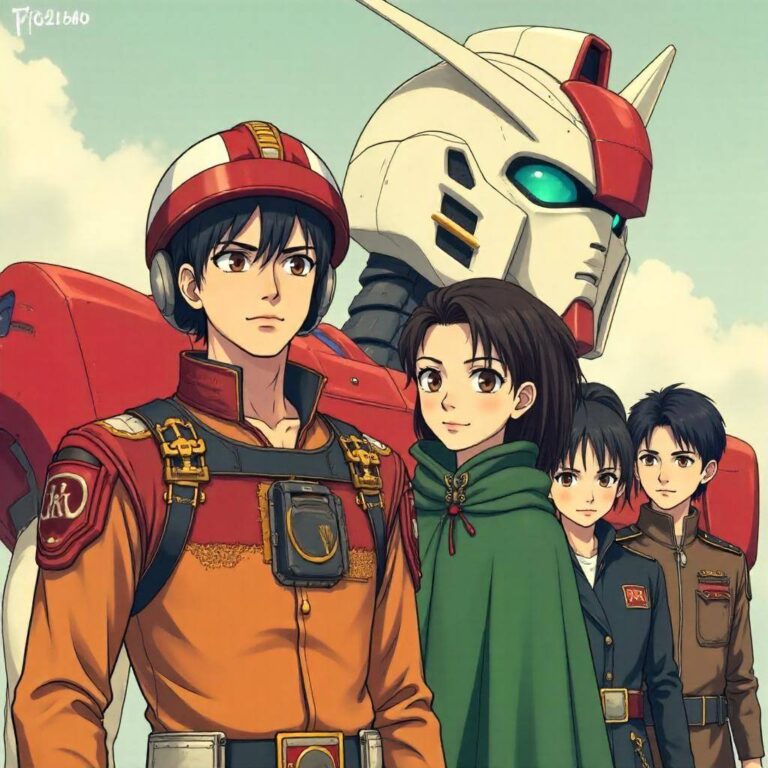Reader’s Question:
Why has Gundam become the pinnacle of robot anime? There are so many robot anime out there, and I believe many of them aim to dominate the genre.
The Pinnacle of Robot Anime: Why Gundam Reigns Supreme
As a kid growing up between California and Osaka, I was surrounded by
a blend of cultures and entertainment—anime being a huge part of that. I remember the first time I saw a Gundam series; it felt like I was witnessing something monumental. Sure, I had seen my fair share of giant robots smashing each other to bits, but Gundam was different. It was like someone had taken the whole robot genre, shook it up, and served it with a side of existential dread and moral complexity. So, why has Gundam become the pinnacle of robot anime? Let’s dive into this.
The Shift from Good vs. Evil to Complex Human Drama
Gundam really flipped the script on what robot anime could be. Before it came along, most mecha series were straightforward tales of good versus evil, catering primarily to kids. But Gundam? It took those giant mechs and placed them in the middle of a tangled web of political intrigue, personal conflict, and moral ambiguity. Suddenly, audiences were faced with questions like: “Is war ever justified?” or “What does it mean to be a hero?” I remember watching “Mobile Suit Gundam” and being completely taken aback by how the characters were not just heroes or villains but complex individuals with conflicting motivations and backgrounds. Who knew a giant robot could make you ponder the human condition?
A Target Audience Gone Awry
It’s funny, though. Despite its groundbreaking approach, Gundam didn’t exactly fly off the shelves upon its initial release. In fact, it was a flop among the very kids it was meant for. The series was just too mature, and I can imagine kids back in the day scratching their heads, wondering why their beloved robots weren’t just out there saving the world in a straightforward way. But here’s where things got interesting: Gundam managed to carve out an entirely new audience. People in their late teens and young adults started tuning in, drawn by the complexity of the story and characters. It was groundbreaking in that sense. Instead of just appealing to the kiddie crowd, it opened the door for older viewers to enjoy anime, and that’s a big deal.
The Real Robot Revolution
I can’t talk about Gundam without mentioning its impact on the “real robot” genre. You see, before Gundam, most mecha anime were highly stylized, with robots that looked more like superheroes than machines. Then came along Yamato, setting the stage for a more realistic approach to robotics in anime. Gundam took that concept and ran with it, combining human emotions with man-made machines in a way that felt relatable. Watching the Gundams in action, you might think, “Wow, if these machines were real, how would people really react?” It’s that level of realism that makes it stand out against its flashy predecessors. And let’s be honest, who doesn’t love the sound of metal clashing, the whirr of machinery, and the epic battle scenes?
The Merchandising Bonanza
Now, let’s talk about the merchandise, because honestly, that’s where a lot of the magic happened post-Gundam’s original run. While the initial toy sales didn’t exactly set the world on fire, the rise of model kits (or “Gunpla,” as they’re affectionately known) created a cultural phenomenon. People weren’t just watching the show; they wanted to build it. I can still remember the first time I walked into a hobby shop in Osaka and saw shelves lined with Gundam model kits. It was like stepping into a mecha paradise! I spent hours just contemplating which one to buy. The attention to detail and the creativity involved in building these kits drew in countless fans, and before long, Gunpla was a staple in hobby shops around the world. Gundam didn’t just die after the series ended; it kept evolving. New models, spin-offs, and even movies kept rolling out. It was like Gundam had its own life force, one that continued long after the screens went dark.
The Cultural Impact
Now, let’s zoom out a bit. The cultural impact of Gundam is colossal. It’s not just an anime; it’s a part of Japan’s pop culture identity. You can find references to Gundam in various forms of media, from video games to music. The designs are iconic, and the series has inspired a whole generation of creators, both in Japan and internationally. I remember attending a local anime convention in California, and it was amazing to see how many fans were sporting Gundam gear—t-shirts, hats, and even cosplay. There’s this shared love for Gundam that transcends borders, and it’s heartwarming to see how it resonates with people from different backgrounds.
The Legacy Continues
So, what does the future hold for Gundam? Well, it seems like the franchise isn’t going anywhere anytime soon. With new series, movies, and even virtual reality experiences on the horizon, Gundam continues to adapt and thrive. For me personally, Gundam is more than just a nostalgic trip down memory lane. It’s a reminder of how storytelling can evolve, pushing boundaries and challenging perceptions. The mix of deep themes, relatable characters, and epic robot battles makes it a timeless classic. As I sit here reminiscing about my childhood, I can’t help but feel grateful for shows like Gundam that made me think, laugh, and even feel a little philosophical. It’s a reminder that even in a world filled with giant robots, the real battles often happen within ourselves. In conclusion, Gundam has become the pinnacle of robot anime not just because of its iconic mechs, but due to its ability to craft compelling human stories that resonate with audiences of all ages. Here’s to hoping it continues to inspire and entertain for many years to come!



